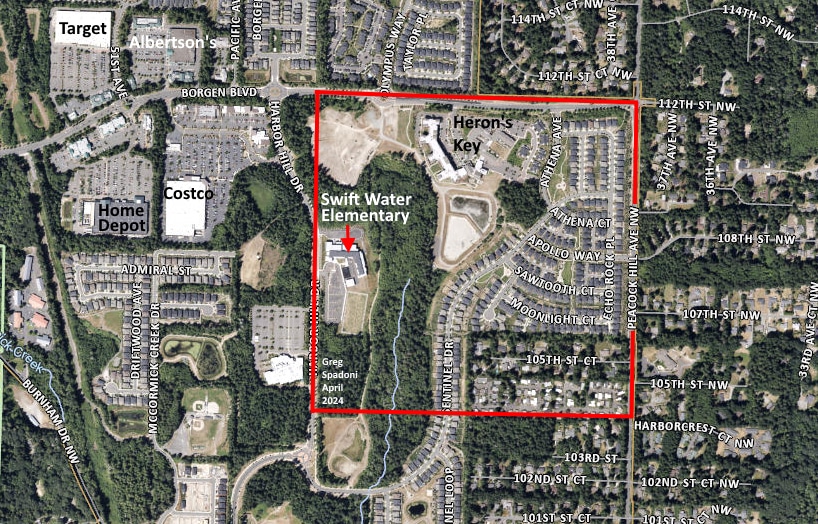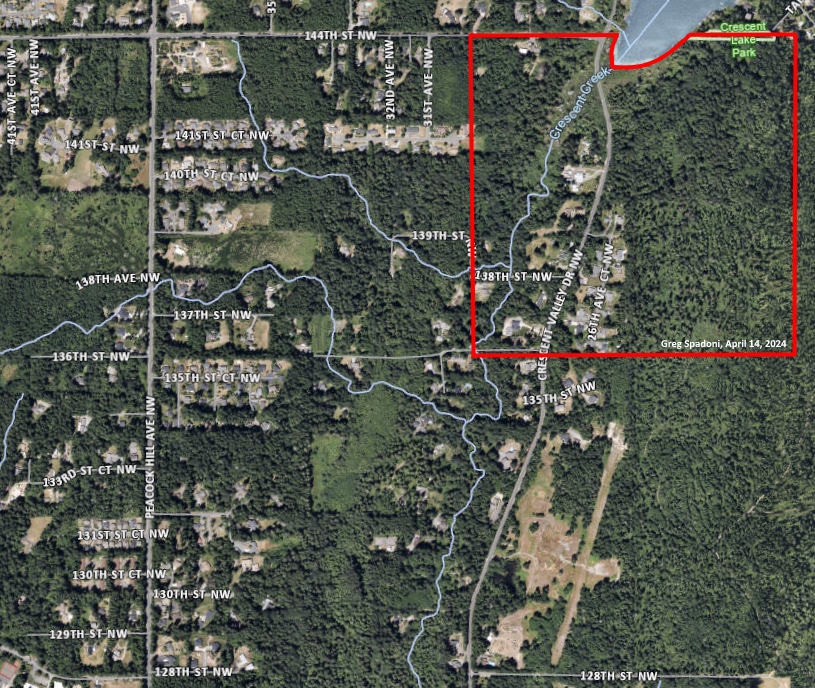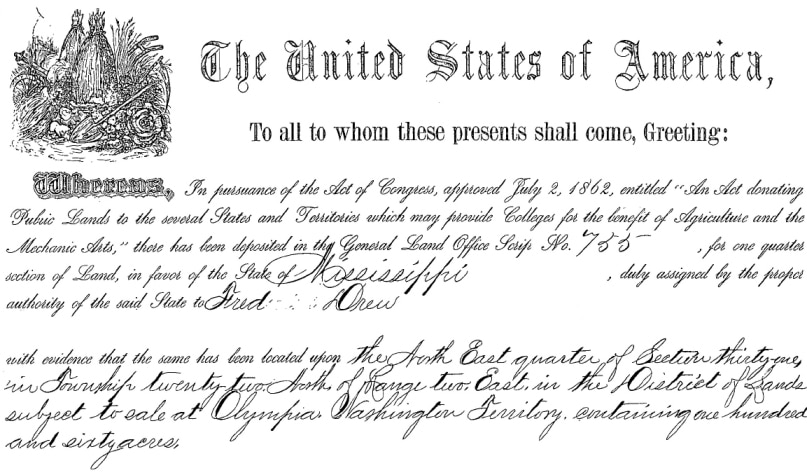Arts & Entertainment Community
Gig Harbor Now and Then | The state of Mississippi once owned over 300 acres of Gig Harbor land

Swift Water Elementary School in Gig Harbor occupies a small portion of a quarter-section of land reserved over 150 years ago for the benefit of education. The 160-acre quarter section is outlined in red. Pierce County Assessor-Treasurer aerial base map.
Gig Harbor Now and Then’s previous question concerns a specific piece of land inside the Gig Harbor city limits, granted by the federal government over 150 years ago for the exclusive benefit of education. The question is:
Community Sponsor
Community stories are made possible in part by Peninsula Light Co, a proud sponsor of Gig Harbor Now.
What was the name of the government entity in possession of the land in 1872?
Answer: The state of Mississippi.
What?!
The state of Mississippi.
Yes, I was surprised too.
Mississippi was granted at least two pieces of Washington Territory land in Gig Harbor. In addition to the 160 acres inside the current city limits at the southwest corner of Borgen Boulevard and Peacock Hill Avenue, it also received 155.5 acres off the south tip of Crescent Lake.

This land in Crescent Valley was also granted to the state of Mississippi by the federal government. Pierce County Assessor-Treasurer aerial base map.
The granting of Washington Territory land to the state of Mississippi came about through the passage of specific legislation in 1862 by both houses of Congress, and signed into law by President Lincoln. Officially, it’s titled “An act donating Public Lands to the several States and Territories which may provide Colleges for the benefit of Agriculture and the Mechanical Arts.”
Less formally, it’s referred to as the Morrill Act. According to this page of the National Archives’ website, the Act “made it possible for states to establish public colleges funded by the development or sale of associated federal land grants.”

The state of Mississippi transferred its two land grants in Gig Harbor to Fred Drew in 1872. This document represents the one that now hosts Swift Water Elementary School. The legal description reads: “The North East quarter of Section thirty-one, Township twenty-two North, of Range two East, in the District of Lands subject to sale at Olympia, Washington Territory, containing one hundred and sixty acres.” From the U.S. Department of the Interior Bureau of Land Management General Land Office Records.
While the land granted was usually located within the state it was granted to, exceptions were made in cases where there simply wasn’t enough good federal land to serve the purpose. Under those circumstances, federal land in other states or territories was granted. The land beneath Swift Water Elementary is one of those instances.
A more prominent example is Cornell University in Ithaca, New York. It was funded under the Morrill Act through grants of timber land in Wisconsin to the state of New York.
There was a variety of land acts passed by Congress over many years. While the Morrill Act mentions college land donations to territories in its official title, certain other acts provided only for the reservation of selected lands by territorial governments, to be granted only upon statehood. The Gig Harbor Peninsula saw some of those too, but that’s a story for another time.
More cool local school history
Swift Water Elementary is not the only school in the Peninsula District with an interesting connection to the land upon which it sits. Pioneer Elementary too has a nice tie-in, being located on the homestead of a very prominent early Gig Harbor family. The patriarch of that family happened to be responsible for Gig Harbor’s very first public school. That made him a pioneer in more than one sense.
Several years ago, when the school district’s central office was notified that Pioneer Elementary is on the land of an actual local pioneer, the one responsible for Gig Harbor’s first public school, no less, it responded with the unmistakable sound of crickets. Rightly or wrongly, it would be easy to draw the conclusion that history is of little or no concern to the administrators of the district’s schools. That would certainly make the name “Pioneer” an odd choice for one of their schools, wouldn’t it?
Sometimes in life there is justice
Only because it’s a neat little anecdote which is unlikely to ever fit into any other story of local history, so would otherwise be lost, here’s something indirectly tied to the Mississippi land grant in Gig Harbor:
Fred Drew, who acquired the Gig Harbor land from the state of Mississippi in 1872, became a fairly wealthy man by the time he died at age 88 in 1926. He had lost his wife in 1910, and in his failing years was attended to by the same woman who had cared for his dying spouse.
Mae Haw had been essentially a maid at the hotel in Seattle where Drew and his wife lived. He recognized and appreciated the dedication of Mrs. Haw, a widow, to the care of both him and his wife, and told her so. He also showed her his appreciation after his death. He bequeathed to her in his will $51,000. That’s equivalent to about $887,000 today.
It may be pure speculation on my part, but I can’t help but suspect that Mrs. Haw, at 58 years old, with 24 more years to live, probably gave up the maid gig.
Gig Harbor’s first big industry
This week’s question is another really good one, for it brings us face to face with one of the most enduring and frequently repeated errors of local history. It’s been written 1,000 times — well, maybe not a thousand; more like 10,000 — that commercial fishing was Gig Harbor’s first big industry. It was not. This week’s question involves logging, which was Gig Harbor’s first major industry.
Yes, when Samuel Jeresich came to Gig Harbor in 1868 (while 1867 is the more commonly given date, I have strong reason to believe 1868 is correct) and started fishing locally, it was the beginning of what would become a big industry. Logging, however, had come to the Harbor a decade earlier, and was a bigger local industry for at least 50 years. But the roots of either industry are subjects for another time.
Turning to the question at hand, in the early days of local logging, it was commonplace on the entire Gig Harbor and Key peninsulas to see signs posted outside of businesses, boarding houses, community halls, and some private homes, prohibiting a certain behavior inside those buildings. The signs were directed specifically at loggers, and no one else.
What certain behavior did those signs prohibit?
This may or may not be a hint: commonly — maybe even most often — those signs were misspelled.
Loggers can get into all kinds of trouble, as can other groups, but this kind of trouble was theirs alone. When it happened, there was no denying who did it.
We’ll have the answer on May 20. In addition, we’ll also present the second-ever Gig Harbor Now and Then editorial opinion. Yes, that’s right, once was not enough. This time we’ll lambaste virtually every elected official of the city of Gig Harbor, from 1960 to the present day. Why? Simply because they deserve it.
Greg Spadoni of Olalla has had more access to local history than most life-long residents. During 25 years in road construction working for the Spadoni Brothers, his first cousins, twice removed, he traveled to every corner of the Gig Harbor and Key Peninsulas, taking note of many abandoned buildings, overgrown farms, and roads that no longer had a destination. Through his current association with the Harbor History Museum in Gig Harbor as the unofficial Chief (and only) Assistant to Linda McCowen, the Museum’s primary photo archive volunteer, he regularly studies the area’s largest collection of visual history. Combined with the print history available at the Museum and online, he has uncovered countless stories of long-forgotten local people and events.

